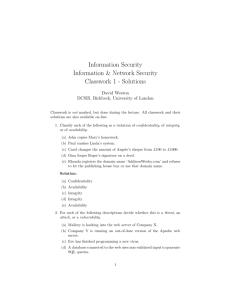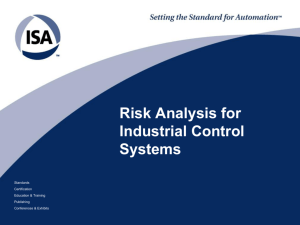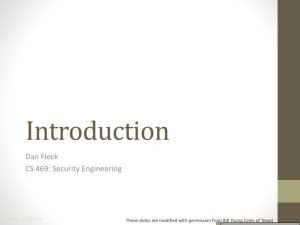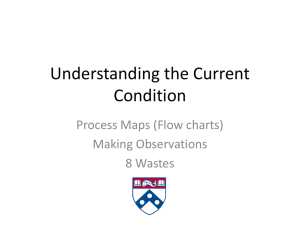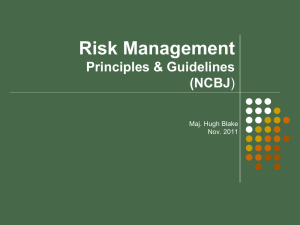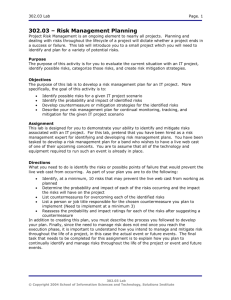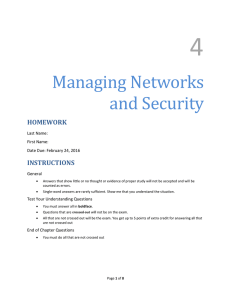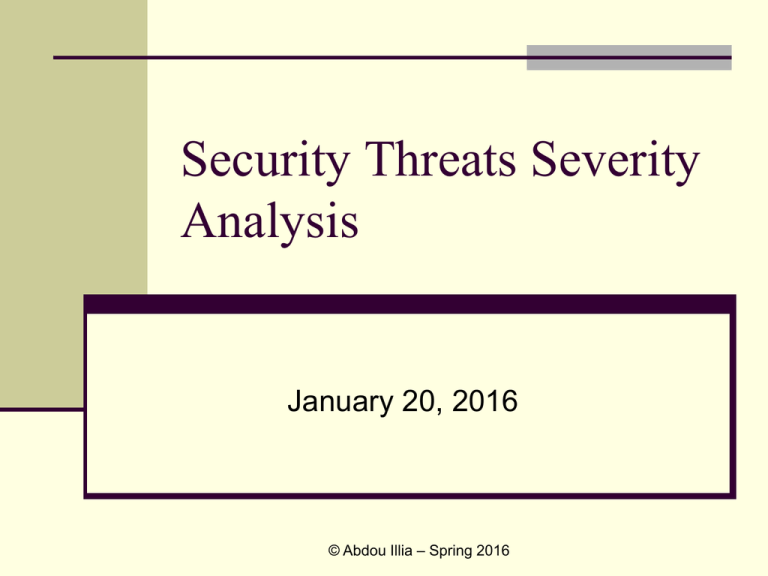
Security Threats Severity
Analysis
January 20, 2016
© Abdou Illia – Spring 2016
What is Severity Analysis?
Accessing security threats occurrence
likelihood
Accessing threats’ potential damage
2
Key Questions to be asked
What resources do I need to protect?
What is the risk associated with potential
threats?
How do I protect valuable resources?
At what cost?
3
What resources do I need to protect?
Do an inventory
External server using internal SQL database to provide sales over the internet
Internal email server
Remote Access server for dial-up
Backup/File server
Internal eCommerce Web server
Domain controller
Sales, customers, inventory, HR data
Company’s network including routers, firewalls, etc.
…………………….
Do risk assessment
Quantitative risk assessment
NIST Guide: http://www.nist.gov/itl/csd/risk-092011.cfm
Assessment Template:
http://www.eiu.edu/~a_illia/MIS4850/RiskAssmt_Template_07112007.doc
Qualitative risk assessment
4
Accessing potential damage
Determining extent to which a threat could
Modify critical corporate data
Delete critical corporate data
Allow unauthorized access to confidential info.
Allow misdirection of confidential info.
Allow message alteration
Slow down network services
Jeopardize network service availability
Lead to loss of customers’ faith and trust
Lead to loss of employees or customers’ privacy
5
Example: Risk assessment
Treat
Vulnerability
Damage
Loss of power
High
Loss of data access
Possible data loss
Computer virus
High
Loss of access to system
Possible data loss
Natural disaster
Low
Loss of access to system
Loss of data, hardware
Denial of service attack
High
Loss of access to system
Eavesdropping
Medium
Access to customers info
………
………
6
How do I protect valuable resources?
Policies
Acceptable use policy
Firewall policies
Confidential info policy
Password policy
Remote Access policy
Security Awareness policy
…
Methods of protection
Antivirus
128-key encryption
Two-factor authentication
…..
7
Threat Severity Analysis
Step
Threat
A
B
C
D
1
Cost if attack succeeds
$500,000
$10,000
$100,000
$10,000
2
Probability of occurrence
80%
20%
5%
70%
3
Threat severity
$400,000
$2,000
$5,000
$7,000
4
Countermeasure cost
$100,000
$3,000
$2,000
$20,000
5
Value of protection
$300,000
($1,000)
$3,000
($13,000)
6
Apply countermeasure?
Yes
No
Yes
No
7
Priority
1
NA
2
NA
8
Exercise
Visit the www.sophos.com web site in order to
gather information about a worm called
W32/SillyFDC-FA and answer the following two
questions.
1)
2)
Using bullets, list specific malicious actions that
W32/SillyFDC-FA could take to potentially damage
or disturb a computer system.
Use the questionnaire provided by the instructor to
access the potential risk posed by W32/SillyFDCFA.
A complete In-class Exercise will be given in class with more details. 9
Realities
Can never eliminate risk
“Information assurance” is impossible
Risk Analysis
Goal is reasonable risk
Risk analysis weighs the probable cost of
compromises against the costs of
countermeasures
Also, security has negative side effects that
must be weighed
10
Copyright Pearson Prentice Hall 2013
Asset Value (AV)
X Exposure Factor (EF)
Percentage loss in asset
value if a compromise
occurs
= Single Loss Expectancy
(SLE)
Expected loss in case of a
compromise
Single Loss Expectancy
(SLE)
SLE
X Annualized Rate of
Occurrence (ARO)
Annual probability of a
compromise
= Annualized Loss
Expectancy (ALE)
Expected loss per year
from this type of
compromise
Annualized Loss
Expectancy (ALE)
11
Copyright Pearson Prentice Hall 2013
Base
Case
Asset Value (AV)
Countermeasure
A
$100,000
$100,000
80%
20%
$80,000
$20,000
Annualized Rate of Occurrence (ARO)
50%
50%
Annualized Loss Expectancy (ALE): =
SLE*ARO
$40,000
$10,000
ALE Reduction for Countermeasure
NA
$30,000
Annualized Countermeasure Cost
NA
$17,000
Annualized Net Countermeasure Value
NA
$13,000
Exposure Factor (EF)
Single Loss Expectancy (SLE): = AV*EF
Countermeasure A should reduce the exposure factor by
12
75%
Copyright Pearson Prentice Hall 2013
2.4: Classic Risk Analysis Calculation (Figure 214) (continued)
Base
Case
Asset Value (AV)
Countermeasure
B
$100,000
$100,000
80%
80%
$80,000
$80,000
Annualized Rate of Occurrence (ARO)
50%
25%
Annualized Loss Expectancy (ALE): =
SLE*ARO
$40,000
$20,000
ALE Reduction for Countermeasure
NA
$20,000
Annualized Countermeasure Cost
NA
$4,000
Annualized Net Countermeasure Value
NA
$16,000
Exposure Factor (EF)
Single Loss Expectancy (SLE): = AV*EF
Countermeasure B should cut the frequency of
13
compromises in half
Copyright Pearson Prentice Hall 2013
2.4: Classic Risk Analysis Calculation (Figure 214) (continued)
Base
Case
Countermeasure
A
B
Asset Value (AV)
$100,000
$100,000
Although Countermeasure A reduces the ALE more,
Exposure Factor (EF)
Countermeasure B is much less80%
expensive. 20%
$100,000
Single Loss Expectancy
(SLE):
AV*EF
$80,000
$20,000
The annualized
net= countermeasure
value for B is
larger.
$80,000
Annualized Rate ofThe
Occurrence
50%
company (ARO)
should select countermeasure
B. 50%
25%
Annualized Loss Expectancy (ALE): =
SLE*ARO
80%
$40,000
$10,000
$20,000
ALE Reduction for Countermeasure
NA
$30,000
$20,000
Annualized Countermeasure Cost
NA
$17,000
$4,000
Annualized Net Countermeasure Value
NA
$13,000
$16,000
14
Copyright Pearson Prentice Hall 2013
2.4: Problems with Classic Risk
Analysis Calculations
Uneven Multiyear Cash Flows
For both attack costs and defense costs
Must compute the return on investment (ROI)
using discounted cash flows
Net present value (NPV) or internal rate of return
(ROI)
15
Copyright Pearson Prentice Hall 2013
Total Cost of Incident (TCI)
◦ Exposure factor in classic risk analysis assumes that a
percentage of the asset is lost
◦ In most cases, damage does not come from asset loss
◦ For instance, if personally identifiable information is
stolen, the cost is enormous but the asset remains
◦ Must compute the total cost of incident (TCI)
◦ Include the cost of repairs, lawsuits, and many other
factors
16
Copyright Pearson Prentice Hall 2013
2.4: Problems with Classic Risk
Analysis Calculations
Many-to-Many Relationships between
Countermeasures and Resources
Classic risk analysis assumes that one
countermeasure protects one resource
Single countermeasures, such as a firewall, often
protect many resources
Single resources, such as data on a server, are
often protected by multiple countermeasures
Extending classic risk analysis is difficult
17
Copyright Pearson Prentice Hall 2013
2.4: Problems with Classic Risk
Analysis Calculations
Impossibility of Knowing the Annualized
Rate of Occurrence
There simply is no way to estimate this
This is the worst problem with classic risk
analysis
As a consequence, firms often merely rate their
resources by risk level
18
Copyright Pearson Prentice Hall 2013
2.4: Problems with Classic Risk
Analysis Calculations
Problems with “Hard-Headed Thinking”
Security benefits are difficult to quantify
If only support “hard numbers” may underinvest in
security
19
Copyright Pearson Prentice Hall 2013
2.4: Problems with Classic Risk
Analysis Calculations
Perspective
Impossible to do perfectly
Must be done as well as possible
Identifies key considerations
Works if countermeasure value is very large or
very negative
But never take classic risk analysis seriously
20
Copyright Pearson Prentice Hall 2013
Risk Reduction
The approach most people consider
Install countermeasures to reduce harm
Makes sense only if risk analysis justifies the
countermeasure
Risk Acceptance
If protecting against a loss would be too
expensive, accept losses when they occur
Good for small, unlikely losses
Good for large but rare losses
21
Copyright Pearson Prentice Hall 2013
2.4: Responding to Risk
Risk Transference
Buy insurance against security-related losses
Especially good for rare but extremely
damaging attacks
Does not mean a company can avoid working
on IT security
If bad security, will not be insurable
With better security, will pay lower premiums
22
Copyright Pearson Prentice Hall 2013
2.4: Responding to Risk
Risk Avoidance
Not to take a risky action
Lose the benefits of the action
May cause anger against IT security
Recap: Four Choices when You Face Risk
Risk reduction
Risk acceptance
Risk transference
Risk avoidance
23
Copyright Pearson Prentice Hall 2013

